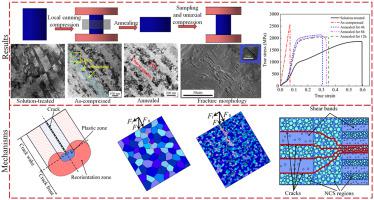Journal of Alloys and Compounds ( IF 6.2 ) Pub Date : 2021-06-16 , DOI: 10.1016/j.jallcom.2021.160797 Bingyao Yan , Yanqiu Zhang , Shuyong Jiang , Junbo Yu , Dong Sun , Ming Tang

|
Mechanical properties and fracture mechanisms of martensitic NiTi shape memory alloy (SMA) were investigated based on various thermomechanical-processing microstructures, where the thermomechanical processing was realized via local canning compression (LCC) and post-deformation annealing at 450 °C. Severe plastic deformation (SPD) occurs when the solution-treated martensitic NiTi SMA is compressed to 50% deformation by LCC, where amorphous structure (AMS) embedded with nano-sized crystalline inclusions (NCIs) and nanocrystalline structures (NCS) involving nanograined structures (NGS) and nanosubgrained structures (NSS) are dominant. Post-deformation annealing at 450 °C leads to the nanocrystallization of AMS, the formation of NSS as well as the growth of NCIs and NGS. The microstructure difference aroused by thermomechanical processing leads to the results that the alloy annealed at 450 °C presents much lower plasticity but higher fracture strength compared with the solution-treated one, while the as-compressed alloy exhibits no plasticity but extremely high fracture strength. In addition, the microstructure difference induced by thermomechanical processing also results in various fracture characteristics. The significant decrease of plasticity in the annealed alloy lies in two aspects, where the first one is that the decrease of reorientation+detwinning zone and plastic zone weakens their shielding effect of preventing the crack growth, and the second one is that crack-path configuration difference leads to larger proportion of fracture mode Ⅰ in the annealed alloy. The river pattern on the brittle fracture surface of the as-compressed alloy is induced by the convergence of cracks which propagate on a serial of parallel interfaces between shear bands and NCS regions.
中文翻译:

基于各种热机械加工显微组织的马氏体NiTi形状记忆合金的力学性能和断裂机制
基于各种热机械加工微观结构研究了马氏体 NiTi 形状记忆合金 (SMA) 的机械性能和断裂机制,其中通过局部罐装压缩 (LCC) 和 450 °C 变形后退火实现了热机械加工。当固溶处理的马氏体 NiTi SMA 被 LCC 压缩至 50% 变形时发生严重塑性变形 (SPD),其中嵌入纳米尺寸晶体夹杂物 (NCIs) 的非晶结构 (AMS) 和涉及纳米晶粒结构的纳米晶体结构 (NCS)。 NGS)和纳米亚晶粒结构(NSS)占主导地位。450°C 的变形后退火导致 AMS 的纳米化、NSS 的形成以及 NCI 和 NGS 的生长。热机械加工引起的显微组织差异导致在 450 °C 退火的合金与固溶处理的合金相比塑性低得多但断裂强度更高,而压缩后的合金没有塑性但断裂强度极高。此外,由热机械加工引起的微观结构差异也会导致各种断裂特征。退火合金塑性的显着下降有两个方面,一是重取向+去孪晶区和塑性区的减少削弱了它们防止裂纹扩展的屏蔽作用,二是裂纹路径配置差异导致退火合金中断裂模式Ⅰ的比例较大。



























 京公网安备 11010802027423号
京公网安备 11010802027423号